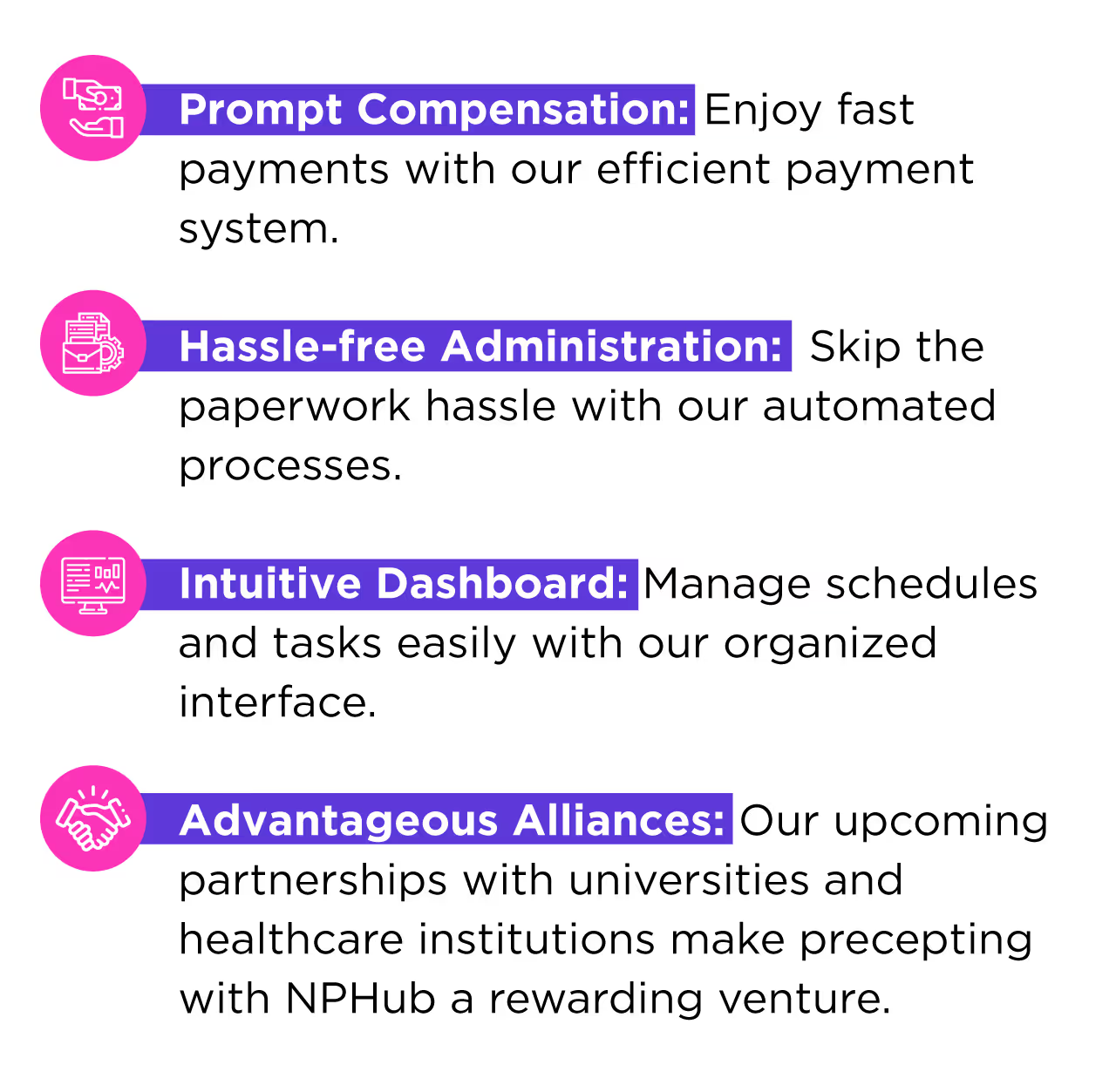In today’s rapidly evolving healthcare landscape, the demand for Nurse Practitioners (NPs) continues to surge, with projections showing a 40% growth from 2023 to 2033. At the heart of this growth lies a critical component: the relationship between NP students and their clinical preceptors.
Becoming a Nurse Practitioner is tough enough without having to navigate the wild world of clinical rotations. And if you’re a preceptor? Well, you’re basically trying to juggle patient care, teaching, and mountains of paperwork all at once. No pressure, right?
A clinical match service is crucial in ensuring NP students are paired with preceptors who can provide the best hands-on clinical experiences, making the process easier and more controlled for both parties.
But great preceptors shape great NPs, and great NPs build a better healthcare system for everyone. So let’s talk about how we can actually support the people making this happen.
In this blog, we’ll share five (and a bonus) effective strategies to bolster support for NP preceptors, along with a bonus sixth method that benefits preceptors and rewards them for their essential mentorship.
1. Give preceptors what they actually need
Forget about throwing a dusty orientation manual at your preceptors and calling it a day. What works is giving them practical tools they can actually use.
In 2019, the National Organization of Nurse Practitioner Faculties (NONPF) and the American Association of Nurse Practitioners (AANP) joined forces to solve a huge problem in NP education. They created two powerful tools: the Preceptor Expectation Checklist and the Faculty Expectation Checklist. But these aren't just your typical boring checklists that collect dust on a shelf.
Why are these checklists such a big deal? Because they actually address the real-world challenges that preceptors, faculty, and students face every day. Think of them as relationship guides for the clinical education world - they help everyone speak the same language and work toward the same goals.
These evidence-based tools do three crucial things:
- Break down communication barriers between preceptors and faculty
- Set clear expectations for everyone involved
- Create healthier, more sustainable teaching relationships
But here's the really important part: these resources were built from actual research published in the Journal of the American Association of Nurse Practitioners. We're talking about proven strategies that work in the real world, not just theory.
This practical checklists are just the beginning. Today's successful preceptors need:
- Quick-access guides for common teaching challenges
- Real-world case studies from experienced mentors
- Templates for student evaluation that don't take hours to complete
- Direct lines of communication with faculty members
But here's what makes these resources truly valuable: they're designed to fit into a preceptor's already busy day. No one needs another three-hour training video they'll never watch. What works are bite-sized resources that solve real problems in real time.
2. Motivation catalysts for Nurse Practitioner preceptors
Ever wonder what actually drives healthcare professionals to take on the challenge of precepting? Well, we don’t have to guess anymore.
A study that examined factors influencing preceptors’ willingness to precept nurse practitioner students before and after COVID-19 revealed what drives them - and it goes way beyond just teaching clinical skills.
This study uncovered that preceptorship is powered by two core motivators: pure altruism and a deep commitment to mentorship. Matching students with the right preceptors can significantly enhance the mentorship experience and fulfill preceptors' motivations.
Let’s talk about altruism first. Despite the challenges they face, preceptors consistently choose to share their time and expertise with future NPs. This spirit of giving back shows up in two ways:
- A deep respect for the NP profession, with preceptors saying things like: “This is something I wanted to kind of pay forward because we need good nurse practitioners out there.”
- A genuine devotion to student growth, finding fulfillment in “seeing the student’s progress throughout their rotation… watching their professional growth and the growth in their level of confidence when it comes to patient management.”
But here’s where it gets really interesting: the mentorship piece. The research shows it’s not just about clinical supervision - it’s about building lasting professional relationships that transform both preceptor and student.
As one participant explained: “Mentorship is lifelong after that point… even though it changes some, once they graduate, once they take a job, once they have a couple years of experience under their belts, it’s more of a professional type of relationship but there’s a little bit of that mentorship that’s still residual.”
This isn’t just wishful thinking - it’s evidence-based feedback from the frontlines. And here’s where smart programs are taking notice and making changes that actually work.
3. Recruitment and retention tactics
Recent research has uncovered some game-changing strategies that ensure a steady supply of skilled preceptors. The key isn’t just recruiting, it’s about building a complete support system that makes them want to stay. Services that help find NP preceptors quickly and efficiently can significantly improve recruitment and retention by streamlining the clinical placement process for NP students. Here’s what’s making a real difference:
Building strong partnerships
Smart programs are fostering deep connections between educational institutions and healthcare organizations. This isn’t just about paperwork - it’s about creating relationships that benefit everyone involved. When clinical sites and schools work together, they can expand their preceptor pool while ensuring everyone’s needs are met.
These partnerships are crucial for providing clinical experiences in various specialties, including family practice.
Making precepting worth their time
Let's be honest - preceptors invest significant time and energy in teaching. Progressive programs are recognizing this through:
- Meaningful recognition programs that go beyond certificates
- Fair financial compensation that acknowledges their expertise
- Incentives that actually matter to practicing professionals
Creating real support systems
Throwing preceptors into the deep end doesn't work. The most successful programs are:
- Providing comprehensive orientation and training from day one
- Offering ongoing support throughout the preceptorship journey
- Maintaining open communication channels between all parties
- Building communities where preceptors can connect and share experiences
Respecting their reality
Here's something crucial: preceptors are busy healthcare professionals first. The best programs understand this by:
- Offering flexible scheduling options
- Accommodating clinical practice responsibilities
- Creating efficient processes that don't add to their workload
- Establishing clear communication channels that respect their time

4. Making virtual preceptorship work
Remember when we thought virtual clinical education was just a temporary fix? Well, surprise! It's here to stay and when it comes to distance NP education, there's a unique set of challenges that need to be tackled.
Here's what actually works in the virtual preceptorship world:
Technology that makes sense
- Student information needs to be accessible and organized - 91% of preceptors say having a comprehensive preceptorship package/manual is essential
- Faculty contact before and during the practicum (67% and 55% respectively found this helpful)
- Simple but effective communication channels between all parties
Supporting from afar
- Regular check-ins between faculty and preceptors (55% report this as valuable)
- Clear processes for student evaluation and feedback
- Easy access to program resources and support staff
- Coordination of clinical site requirements and EMR training (over 65% ranked this as important)
Making space for success
Distance learning doesn't mean disconnected learning. Smart programs are:
- Ensuring preceptors have adequate physical space to work with students (59% identified this as crucial)
- Providing time for consultation with faculty about student progress (45% say this matters)
- Creating structured opportunities for feedback and evaluation
- Supporting both the teaching and clinical responsibilities of preceptors
5. Building strong Academic-Practice Alliances
You know that old saying about “it takes a village”? Well when it comes to supporting NP preceptors it really does. Research from the Journal for Nurse Practitioners shows it’s not just about connecting institutions; it’s about creating support systems that work for the people doing the teaching.
With the growing number of NP programs in the United States, it is crucial to build strong academic-practice alliances to ensure quality clinical experiences for students.
What really works
Smart programs are building partnerships that put preceptors first:
- Getting practice managers and medical directors on board (28.75% of preceptors say this is crucial for support)
- Working with Advanced Practice Councils to understand what preceptors really need
- Creating direct lines to academic coordinators when preceptors need backup
Making support accessible
Preceptors tell us they thrive when partnerships provide:
- Access to free continuing education programs (the #1 requested support!)
- Real relationships with NP faculty (16.44% say this matters)
- Easy access to teaching resources and clinical materials
- Clear points of contact when they need help
Breaking down barriers
Good partnerships actively remove obstacles for preceptors by:
- Ensuring they have adequate physical space for teaching
- Building flexible scheduling systems that respect their time
- Streamlining administrative requirements
- Providing the tech support they need
Providing clinical experiences in primary care settings is crucial to ensure comprehensive training for NP students.
Bonus: Join NPHub as a Preceptor and reap the rewards
Here’s where things get exciting. While everyone else is just talking about preceptor support, we’re revolutionizing it. Here’s how we’re shaking things up:
NPHub offers clinical rotations in various specialties, including women's health, providing NP students with opportunities to gain experience in gynecology and obstetrics through our extensive network of preceptors.
A Community that gets it
We've created more than just a platform - we've built a community where preceptors actually want to be. Why? Because we understand that great precepting isn't just about checking boxes. It's about creating those meaningful connections that make teaching worthwhile.
What makes us different
- Fair compensation, finally: We believe NP preceptors deserve to be paid for their expertise - just like every other healthcare preceptor. No more volunteering your valuable time!
- Hassle-free everything: Remember all that paperwork you used to dread? We've made it 100% electronic. No more email ping-pong with universities.
- You're in control: Hand-pick your ideal students through our detailed student profiles. Because chemistry matters in teaching.
- Support when you need It: Real-time backup from our team, not just during business hours.
- Precept your way: Partner with us on your terms. We match awesome preceptors with awesome students (and yes, it really is fun!)
- Spread the word: Know other great preceptors? Earn $100-$150 for each colleague you bring into our network.
- Shape the future: Help us revolutionize NP clinical education. We're always looking for innovative ideas from our preceptors.
We don't just talk about appreciation - we show it:
- A supportive community of fellow preceptors
- Opportunities to hire your star students after graduation
- Continuous professional development opportunities
Grab the chance to guide the healthcare leaders of tomorrow with NPHub. Be part of something bigger Start your rewarding mentorship journey by becoming a preceptor with us. NPHub offers preceptor matching services that ensure a fulfilling clinical experience for both preceptors and students.

Supporting Preceptors is supporting healthcare's future
Here's the bottom line: the future of healthcare depends on great NPs, and great NPs depend on dedicated preceptors. It's really that simple. But supporting preceptors? That's where things get interesting.
From evidence-based tools and meaningful recognition to strong partnerships and virtual support systems, we've covered five proven strategies that actually work in the real world. More importantly, we've seen how these strategies come together to create an environment where preceptors can thrive, not just survive.
At NPHub, we're taking all of these insights and turning them into action. We understand that preceptorship means creating meaningful connections that strengthen the entire healthcare community. That's why we've built a platform that combines competitive compensation, real support, and a vibrant community of healthcare educators who are passionate about shaping the future.
Our preceptor matching service covers a wide range of specialties, including clinical rotations in women's health, ensuring comprehensive training for NP students and strongly support the preceptors who provide hands-on training. We are committed to offering the necessary support and ensuring fair compensation for their mentorship services.
Our goal is to create a supportive learning environment to save the future of healthcare.
Find a preceptor who cares with NPHub
Book a rotation.webp)








.webp)


.webp)



.webp)